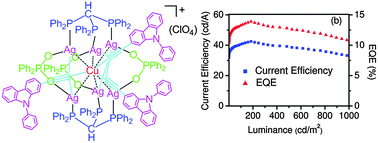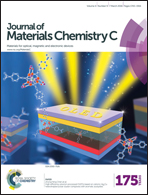High-efficiency solution-processed OLEDs based on cationic Ag6Cu heteroheptanuclear cluster complexes with aromatic acetylides†
Abstract
We report, herein, the use of phosphorescent copper(I)–silver(I) heterometallic complexes to achieve highly efficient electroluminescence. The trigonal prism arranged Ag6Cu heteroheptanuclear alkynyl cluster complexes show intense phosphorescence in a fluid solution, powder and thin film with quantum yields as high as 0.78. Complex 1 with 1-(tert-butyl)-4-ethynylbenzene (HC![[triple bond, length as m-dash]](https://www.rsc.org/images/entities/char_e002.gif) CC6H4But-4) shows reversible phosphorescence vaporchromism in respose to THF or CHCl3. The phosphorescent emission exhibits an obvious blue-shift from 580 nm to 530 nm for THF and to 538 nm for CHCl3 with a remarkable luminescence change from bright yellow to green. As demonstrated experimentally and theoretically, the phosphorescence originates from 3[π(aromatic acetylide) → s/p(Ag6Cu)]3LMCT and Ag6Cu cluster centered 3[d → s/p] triplet states. Taking advantage of the doped light-emitting layer of 57% TCTA:28% OXD-7:15% Ag6Cu complex with hole-transporting TCTA and electron-transporting OXD-7 as a blended host, solution-processed OLEDs gave highly efficient electroluminescence with a current efficiency (CE) of 42.5 cd A−1 and external quantum efficiency (EQE) of 13.9% at low voltage (4.5 V) with a practical brightness of 184 cd m−2.
CC6H4But-4) shows reversible phosphorescence vaporchromism in respose to THF or CHCl3. The phosphorescent emission exhibits an obvious blue-shift from 580 nm to 530 nm for THF and to 538 nm for CHCl3 with a remarkable luminescence change from bright yellow to green. As demonstrated experimentally and theoretically, the phosphorescence originates from 3[π(aromatic acetylide) → s/p(Ag6Cu)]3LMCT and Ag6Cu cluster centered 3[d → s/p] triplet states. Taking advantage of the doped light-emitting layer of 57% TCTA:28% OXD-7:15% Ag6Cu complex with hole-transporting TCTA and electron-transporting OXD-7 as a blended host, solution-processed OLEDs gave highly efficient electroluminescence with a current efficiency (CE) of 42.5 cd A−1 and external quantum efficiency (EQE) of 13.9% at low voltage (4.5 V) with a practical brightness of 184 cd m−2.


 Please wait while we load your content...
Please wait while we load your content...